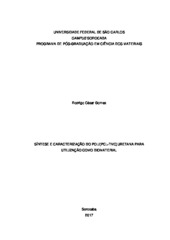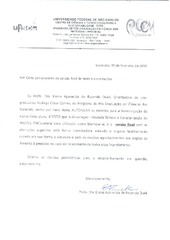| dc.contributor.author | Gomes, Rodrigo Cesar | |
| dc.date.accessioned | 2018-02-28T18:03:25Z | |
| dc.date.available | 2018-02-28T18:03:25Z | |
| dc.date.issued | 2017-03-03 | |
| dc.identifier.citation | GOMES, Rodrigo Cesar. Síntese e Caracterização do Poli(PCL-TMC)uretana para utilização como Biomaterial. 2017. Dissertação (Mestrado em Ciência dos Materiais) – Universidade Federal de São Carlos, Sorocaba, 2017. Disponível em: https://repositorio.ufscar.br/handle/ufscar/9491. | * |
| dc.identifier.uri | https://repositorio.ufscar.br/handle/ufscar/9491 | |
| dc.description.abstract | Among the polymers widely investigated as materials for tissue engineering, polyurethane has its place of prominence, mainly due to the high flexibility and tenacity. The need for devices with certain mechanical properties combined with the ability to be biodegradable and bioreabsorbable motivates the scientific community to increasingly seek the creation of new materials in order to minimize the discomforts and increase the quality of life of the population. The present work aimed to synthesize a new copolymer produced from PCL and TMC with creation of urethane groups in the polymer chain. This synthesis combined the mechanical properties present in Polyurethane and PCL, with the increase of the modulus of elasticity conferred by the TMC, and allowed the increase of the degradation rate of the polyurethane due to the TMC. Prepolymer synthesis occurred in the bulk polymerization between PCL diol and TMC at 50/50 mass ratio using SnOct2 as catalyst. This synthesis was confirmed by FTIR and 1H NMR. The GPC analysis of three samples of the prepolymer showed Mn approximately 6000 g.mol-1 and Mw 12000 g.mol-1 with the IP close to 2. The poly (PCL-TMC) urethane formation occurred via solution polymerization between the prepolymer and HDI using solvent 1,2-dichloroethane and the molar ratio of 1: 2 (prepolymer / HDI). This synthesis was confirmed by FTIR and 1H NMR. Thermal characterization was performed using the DSC and TG techniques. There were no melt and crystallization temperatures in the DSC curve, indicating that the copolymer formed is probably amorphous, and the Tg found was -40 ° C. The TG indicated Tonset and Td, respectively 285 ° C and 301 ° C. Porous were made into the copolymer through solution freeze-drying and SEM test was performed on the porous material, and a mean pore diameter of approximately 38 μm was found, indicating the possibility of cell growth. Therefore, a new copolymer with potential application in biomaterials was created. | eng |
| dc.description.sponsorship | Coordenação de Aperfeiçoamento de Pessoal de Nível Superior (CAPES) | por |
| dc.language.iso | por | por |
| dc.publisher | Universidade Federal de São Carlos | por |
| dc.rights.uri | Acesso aberto | por |
| dc.subject | Poliuretana | por |
| dc.subject | Policaprolactona | por |
| dc.subject | Trimetileno Carbonato | por |
| dc.subject | Biomaterial | por |
| dc.subject | Polyurethane | eng |
| dc.subject | Polycaprolactone | eng |
| dc.subject | Trimethylene Carbonate | eng |
| dc.title | Síntese e Caracterização do Poli(PCL-TMC)uretana para utilização como Biomaterial | por |
| dc.title.alternative | Synthesis and Characterization of Poly(PCL-TMC)urethane for use as Biomaterial | eng |
| dc.type | Dissertação | por |
| dc.contributor.advisor1 | Duek, Eliana Aparecida de Rezende | |
| dc.contributor.advisor1Lattes | http://lattes.cnpq.br/4147198882685212 | por |
| dc.contributor.advisor-co1 | Komatsu, Daniel | |
| dc.contributor.advisor-co1Lattes | http://lattes.cnpq.br/2620060426867863 | por |
| dc.description.resumo | Dentre os polímeros largamente investigados como materiais para a engenharia tecidual, a poliuretana tem o seu lugar de destaque. A necessidade de dispositivos com determinadas propriedades mecânicas aliadas à capacidade de ser biodegradável e biorreabsorvível vem motivando a comunidade científica a buscar cada vez mais novos materiais objetivando minimizar os desconfortos e aumentar a qualidade de vida da população. O presente trabalho objetivou sintetizar um novo copolímero produzido a partir da Policaprolatona (PCL) e do Trimetileno Carbonato (TMC) com inserção de grupos uretanas na cadeia polimérica. Tal síntese possibilitou aliar as propriedades mecânicas presentes na Poliuretana e no PCL, com o aumento da elasticidade conferido pelo TMC, além de permitir o aumento da taxa de degradação, in vivo, da poliuretana devido a presença do TMC. A síntese do pré-polímero ocorreu na polimerização em massa entre o PCL-diol e o TMC com relação 50/50 em massa, utilizando o SnOct2 como catalisador. Esta síntese foi confirmada via FTIR e RMN 1H. A análise de GPC do pré-polímero apresentou Mn aproximadamente de 6.000 g.mol-1, Mw aproximadamente 12.000 g.mol-1 e o IP próximo de 2. A formação do poli(PCL-TMC)uretana ocorreu via polimerização em solução entre o pré-polímero e o HDI, utilizando como solvente o 1,2-dicloroetano e a razão molar de 1 : 2 (pré-polímero/HDI). A confirmação desta síntese ocorreu através do FTIR e do RMN 1H. A caracterização térmica ocorreu através das técnicas de DSC e TG. Não se observou na curva de DSC a temperatura de fusão, indicando que provavelmente o copolímero formado é amorfo, e a Tg encontrada foi de -40 ºC. O TG indicou a Tonset e a Td, sendo respectivamente 285 ºC e 301 ºC. Foram obtidas amostras porosas do copolímero através do processo de liofilização em solução as quais foram analisadas pelo ensaio de MEV, onde se verificou valor de diâmetro médio de poro de aproximadamente 38 µm, indicando a possibilidade de crescimento celular. Desse modo, obteve-se um novo copolímero com potencial aplicação como biomaterial. | por |
| dc.publisher.initials | UFSCar | por |
| dc.publisher.program | Programa de Pós-Graduação em Ciência dos Materiais - PPGCM-So | por |
| dc.subject.cnpq | ENGENHARIAS::ENGENHARIA BIOMEDICA::ENGENHARIA MEDICA::BIOMATERIAIS E MATERIAIS BIOCOMPATIVEIS | por |
| dc.subject.cnpq | CIENCIAS EXATAS E DA TERRA::QUIMICA::QUIMICA ORGANICA::POLIMEROS E COLOIDES | por |
| dc.ufscar.embargo | Online | por |
| dc.publisher.address | Câmpus Sorocaba | por |
| dc.contributor.authorlattes | http://lattes.cnpq.br/9974151176548878 | por |

